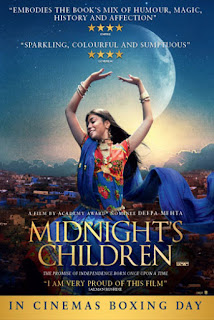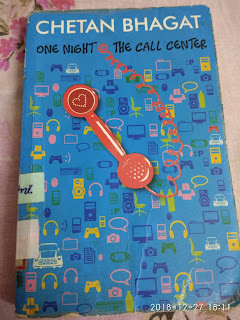Movie review of Midnight's children
On 9th september in Department of English MKBU I saw the movie Midnights children.
This movie is based on Salman Rushdie's novel which has same name.
Movie is directed by Deepa Mehta. This is best booker prize winner movie. Movie and novel present idea of Chatnificaion and movie symbolized allegory of India and symbol of spitton.
About the movie Midnights children:-
Saleem sinai was the hero of movie. Saleem and Shiva born on midnight when India got freedom from Britishers. Same night other children also born.
Nurse interchang the babies:-
When the babies born on that midnight , the nurse of the hospital interchange the babies. So the rich became poor and poor became rich. Shiva always felt jealous to Saleem only because of he was rich and he was poor.
When saleem's teacher injured him, he was in hospital and doctor said his parents that his blood was not matched with both of them. Saleem's father has doubt on him that he was not his son.
After some time the nurse said that by intensionally she interchange babies. Shiva was the real son of the muslim couple.
Nose power:-
Saleem and other babies was born on that midnight so Saleem has one power in his nose and with this he can watch and talk with other children who born on that midnight. Saleem love one girl of them named Parvati.
When Saleem's father know about Saleem's cough he took him in hospital for operation. After the operation he lost the power.
History of India,Pakistan and Bangladesh:-
Here movie presents Indian history like Independent movement ,civil war with pakistan and arising Bangladesh as new country.
Emergency by Indira Gandhi:-
Indira Gandhi declared emergency in India. During this time many poor were died . Government caponize the poor people.
Magic realism:-
India still believe in black magic and superstition though we live in technological era. Parvati has magical power by born and she use it for save the life her husband and her child.
Post colonial view in Midnights children:-
1)Unreliable Narrator:-The first is the lack of a reliable narrator. Building off the idea of a lack of totality that is a part of Postcolonialism, Saleem is far from a totalizing narrator. His dates are wrong. Some of his facts are not accurate. He is a participant in his own narrative, leading to issues of bias. These are all deliberate, as Rushdie seeks to make a statement that there can be no definitive notion of history. Any such construction is going to silence voice and that the best we can do is collect as many narratives as possible. This is a Postcolonialism response to the condition of imposition that sought to present itself as "the truth."
2) Indigenous point of view:-Another element of Postcolonialism in Midnight's Childrenis how it is told from the indigenous point of view. The presence of the British is felt, but the story, itself, is one of Partition and division. Rushdie's use of All India Radio, Bollywood songs, as well appropriating Muslim and Hindu notions of reality help to enhance the Postcolonial understanding of the work. Being able to relay the basis of Partition as well as the Emergency from an indigenous point of view is also reflective of the Postcolonial elements of Midnight's Children.
3)Unnatural narrative:--Unnatural narrative into dialogue with Salman Rushdie’s Midnight’s Children. The novel follows Saleem Sinai as he writes about his life and explains his intimate connection with the evolution of Indian as a nation from the very moment of his birth at the precise moment of Indian independence. Saleem struggles to tell his story on his own terms. His narrative includes the history of his grandparents and parents, a supernatural connection to other children born between the hours of midnight and one that morning, and a rivalry with another midnight’s child who rightfully should have lived Saleem’s life. All the while, the events of his life and the life of his family are intricately meshed with those of India’s history, from the Amritsar massacre of 1919, to the Indo-Pakistani War of 1965, and the ensuing administration of Prime Minister Indira Gandhi and her controversial decision to exercise unilateral power in the mid 1970’s by calling an Indian state of emergency.
4)Magic realism:-One such postcolonial writer is Salman Rushdie, who used magic realism in Midnight’s Children extensively. His fusion of fantasy and reality looks typically Indian because the characters strewn in present social and political disorder likewise own the power of epic heroes. As a novelist from a country with a colonial legacy, Rushdie is also concerned and involved with the concept of nation in his magic realist writing, which was motivated by (1) the necessity to cast away what Coleridge called the film of recent past’ familiarity through the use of fabulation and (2) the dilemma of presenting impossible events. As it is, magic realism is “a reflection of the ‘cultural heterogeneity’ of Latin America—a simultaneity caused by historical sedimentation due to colonialism (i.e., several cultures existing at the same place and time.” If the usual definition of a nation is the same people living in the same place or in different places, the postcolonial idea of national identity as depicted in Midnight’s Children is different: Indians are different people living in the same place.
This movie is based on Salman Rushdie's novel which has same name.
Movie is directed by Deepa Mehta. This is best booker prize winner movie. Movie and novel present idea of Chatnificaion and movie symbolized allegory of India and symbol of spitton.
About the movie Midnights children:-
Saleem sinai was the hero of movie. Saleem and Shiva born on midnight when India got freedom from Britishers. Same night other children also born.
Nurse interchang the babies:-
When the babies born on that midnight , the nurse of the hospital interchange the babies. So the rich became poor and poor became rich. Shiva always felt jealous to Saleem only because of he was rich and he was poor.
When saleem's teacher injured him, he was in hospital and doctor said his parents that his blood was not matched with both of them. Saleem's father has doubt on him that he was not his son.
After some time the nurse said that by intensionally she interchange babies. Shiva was the real son of the muslim couple.
Nose power:-
Saleem and other babies was born on that midnight so Saleem has one power in his nose and with this he can watch and talk with other children who born on that midnight. Saleem love one girl of them named Parvati.
When Saleem's father know about Saleem's cough he took him in hospital for operation. After the operation he lost the power.
History of India,Pakistan and Bangladesh:-
Here movie presents Indian history like Independent movement ,civil war with pakistan and arising Bangladesh as new country.
Emergency by Indira Gandhi:-
Indira Gandhi declared emergency in India. During this time many poor were died . Government caponize the poor people.
Magic realism:-
India still believe in black magic and superstition though we live in technological era. Parvati has magical power by born and she use it for save the life her husband and her child.
Post colonial view in Midnights children:-
1)Unreliable Narrator:-The first is the lack of a reliable narrator. Building off the idea of a lack of totality that is a part of Postcolonialism, Saleem is far from a totalizing narrator. His dates are wrong. Some of his facts are not accurate. He is a participant in his own narrative, leading to issues of bias. These are all deliberate, as Rushdie seeks to make a statement that there can be no definitive notion of history. Any such construction is going to silence voice and that the best we can do is collect as many narratives as possible. This is a Postcolonialism response to the condition of imposition that sought to present itself as "the truth."
2) Indigenous point of view:-Another element of Postcolonialism in Midnight's Childrenis how it is told from the indigenous point of view. The presence of the British is felt, but the story, itself, is one of Partition and division. Rushdie's use of All India Radio, Bollywood songs, as well appropriating Muslim and Hindu notions of reality help to enhance the Postcolonial understanding of the work. Being able to relay the basis of Partition as well as the Emergency from an indigenous point of view is also reflective of the Postcolonial elements of Midnight's Children.
3)Unnatural narrative:--Unnatural narrative into dialogue with Salman Rushdie’s Midnight’s Children. The novel follows Saleem Sinai as he writes about his life and explains his intimate connection with the evolution of Indian as a nation from the very moment of his birth at the precise moment of Indian independence. Saleem struggles to tell his story on his own terms. His narrative includes the history of his grandparents and parents, a supernatural connection to other children born between the hours of midnight and one that morning, and a rivalry with another midnight’s child who rightfully should have lived Saleem’s life. All the while, the events of his life and the life of his family are intricately meshed with those of India’s history, from the Amritsar massacre of 1919, to the Indo-Pakistani War of 1965, and the ensuing administration of Prime Minister Indira Gandhi and her controversial decision to exercise unilateral power in the mid 1970’s by calling an Indian state of emergency.
4)Magic realism:-One such postcolonial writer is Salman Rushdie, who used magic realism in Midnight’s Children extensively. His fusion of fantasy and reality looks typically Indian because the characters strewn in present social and political disorder likewise own the power of epic heroes. As a novelist from a country with a colonial legacy, Rushdie is also concerned and involved with the concept of nation in his magic realist writing, which was motivated by (1) the necessity to cast away what Coleridge called the film of recent past’ familiarity through the use of fabulation and (2) the dilemma of presenting impossible events. As it is, magic realism is “a reflection of the ‘cultural heterogeneity’ of Latin America—a simultaneity caused by historical sedimentation due to colonialism (i.e., several cultures existing at the same place and time.” If the usual definition of a nation is the same people living in the same place or in different places, the postcolonial idea of national identity as depicted in Midnight’s Children is different: Indians are different people living in the same place.





Comments
Post a Comment